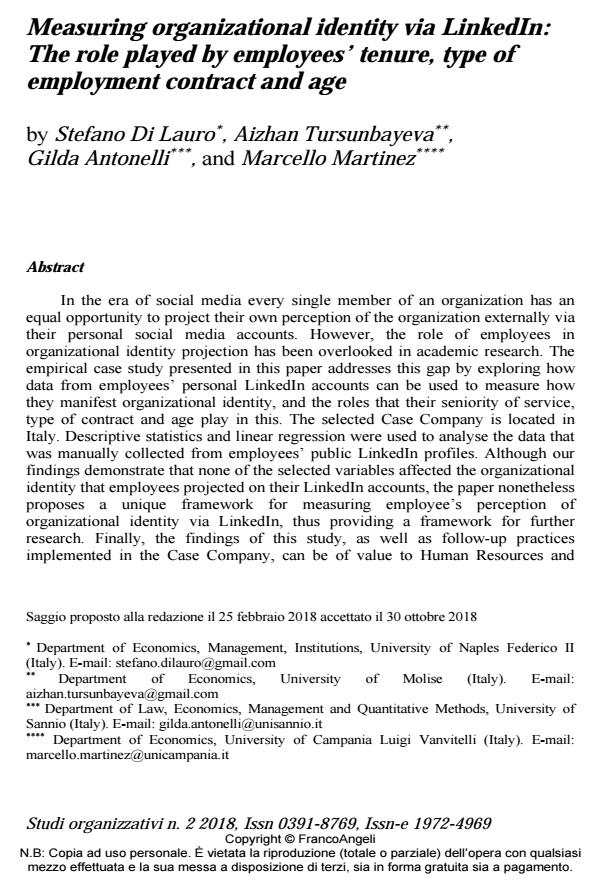Measuring organizational identity via LinkedIn: The role played by employees’ tenure, type of employment contract and age
Journal title STUDI ORGANIZZATIVI
Author/s Stefano Di Lauro, Aizhan Tursunbayeva, Gilda Antonelli, Marcello Martinez
Publishing Year 2019 Issue 2018/2
Language English Pages 16 P. 114-129 File size 243 KB
DOI 10.3280/SO2018-002005
DOI is like a bar code for intellectual property: to have more infomation
click here
Below, you can see the article first page
If you want to buy this article in PDF format, you can do it, following the instructions to buy download credits

FrancoAngeli is member of Publishers International Linking Association, Inc (PILA), a not-for-profit association which run the CrossRef service enabling links to and from online scholarly content.
In the era of social media every single member of an organization has an equal opportunity to project their own perception of the organization externally via their personal social media accounts. However, the role of employees in organizational identity projection has been overlooked in academic research. The empirical case study presented in this paper addresses this gap by exploring how data from employees’ personal LinkedIn accounts can be used to measure how they manifest organizational identity, and the roles that their seniority of service, type of contract and age play in this. The selected Case Company is located in Italy. Descriptive statistics and linear regression were used to analyse the data that was manually collected from employees’ public LinkedIn profiles. Although our findings demonstrate that none of the selected variables affected the organizational identity that employees projected on their LinkedIn accounts, the paper nonetheless proposes a unique framework for measuring employee’s perception of organizational identity via LinkedIn, thus providing a framework for further research. Finally, the findings of this study, as well as follow-up practices implemented in the Case Company, can be of value to Human Resources and Social Media practitioners who are considering whether to introduce or already implementing social media use practices in organizations. .
Keywords: Organizational identity, organizational change, social media, LinkedIn, measurement
- Critical Issues on Changing Dynamics in Employee Relations and Workforce Diversity Francesca Di Virgilio, pp.121 (ISBN:9781799835158)
- Exploring Innovation in a Digital World Stefano Di Lauro, Aizhan Tursunbayeva, Raluca Bunduchi, Gilda Antonelli, Marcello Martinez, pp.291 (ISBN:978-3-030-87841-2)
Stefano Di Lauro, Aizhan Tursunbayeva, Gilda Antonelli, Marcello Martinez, Measuring organizational identity via LinkedIn: The role played by employees’ tenure, type of employment contract and age in "STUDI ORGANIZZATIVI " 2/2018, pp 114-129, DOI: 10.3280/SO2018-002005